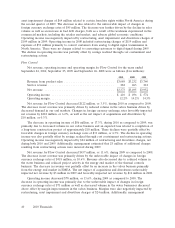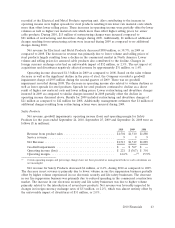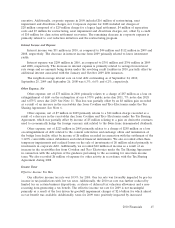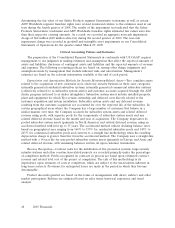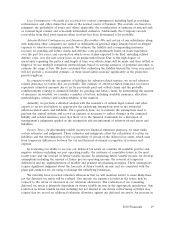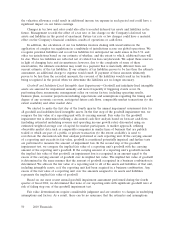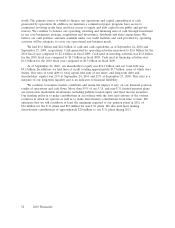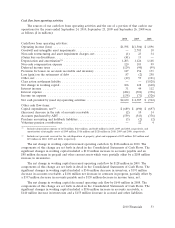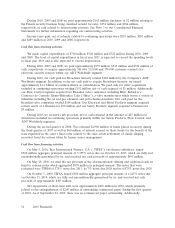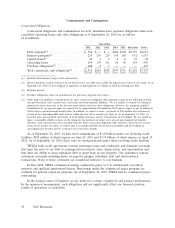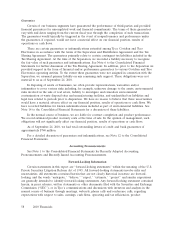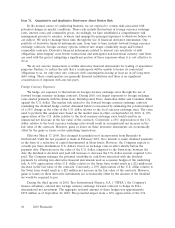ADT 2010 Annual Report Download - page 138
Download and view the complete annual report
Please find page 138 of the 2010 ADT annual report below. You can navigate through the pages in the report by either clicking on the pages listed below, or by using the keyword search tool below to find specific information within the annual report.the valuation allowance could result in additional income tax expense in such period and could have a
significant impact on our future earnings.
Changes in tax laws and rates could also affect recorded deferred tax assets and liabilities in the
future. Management records the affect of a tax rate or law change on the Company’s deferred tax
assets and liabilities in the period of enactment. Future tax rate or law changes could have a material
effect on the Company’s financial condition, results of operations or cash flows.
In addition, the calculation of our tax liabilities involves dealing with uncertainties in the
application of complex tax regulations in a multitude of jurisdictions across our global operations. We
recognize potential liabilities and record tax liabilities for anticipated tax audit issues in the U.S. and
other tax jurisdictions based on our estimate of whether, and the extent to which, additional taxes will
be due. These tax liabilities are reflected net of related tax loss carryforwards. We adjust these reserves
in light of changing facts and circumstances; however, due to the complexity of some of these
uncertainties, the ultimate resolution may result in a payment that is materially different from our
current estimate of the tax liabilities. If our estimate of tax liabilities proves to be less than the ultimate
assessment, an additional charge to expense would result. If payment of these amounts ultimately
proves to be less than the recorded amounts, the reversal of the liabilities would result in tax benefits
being recognized in the period when we determine the liabilities are no longer necessary.
Goodwill and Indefinite-Lived Intangible Asset Impairments—Goodwill and indefinite-lived intangible
assets are assessed for impairment annually and more frequently if triggering events occur. In
performing these assessments, management relies on various factors, including operating results,
business plans, economic projections including expectations and assumptions regarding the timing and
degree of any economic recovery, anticipated future cash flows, comparable market transactions (to the
extent available) and other market data.
We elected to make the first day of the fourth quarter the annual impairment assessment date for
all goodwill and indefinite-lived intangible assets. In the first step of the goodwill impairment test, we
compare the fair value of a reporting unit with its carrying amount. Fair value for the goodwill
impairment test is determined utilizing a discounted cash flow analysis based on forecast cash flows
(including estimated underlying revenue and operating income growth rates) discounted using an
estimated weighted-average cost of capital for market participants. A market approach, utilizing
observable market data such as comparable companies in similar lines of business that are publicly
traded or which are part of a public or private transaction (to the extent available), is used to
corroborate the discounted cash flow analysis performed at each reporting unit. If the carrying amount
of a reporting unit exceeds its fair value, goodwill is considered potentially impaired and further tests
are performed to measure the amount of impairment loss. In the second step of the goodwill
impairment test, we compare the implied fair value of a reporting unit’s goodwill with the carrying
amount of the reporting unit’s goodwill. If the carrying amount of a reporting unit’s goodwill exceeds
the implied fair value of that goodwill, an impairment loss is recognized in an amount equal to the
excess of the carrying amount of goodwill over its implied fair value. The implied fair value of goodwill
is determined in the same manner that the amount of goodwill recognized in a business combination is
determined. We allocate the fair value of a reporting unit to all of the assets and liabilities of that unit,
including intangible assets, as if the reporting unit had been acquired in a business combination. Any
excess of the fair value of a reporting unit over the amounts assigned to its assets and liabilities
represents the implied fair value of goodwill.
Based on our most recent annual goodwill impairment assessment performed during the fourth
quarter of fiscal 2010, we determined that none of our reporting units with significant goodwill were at
risk of failing step one of the goodwill impairment test.
Fair value determinations require considerable judgment and are sensitive to changes in underlying
assumptions and factors. As a result, there can be no assurance that the estimates and assumptions
50 2010 Financials


